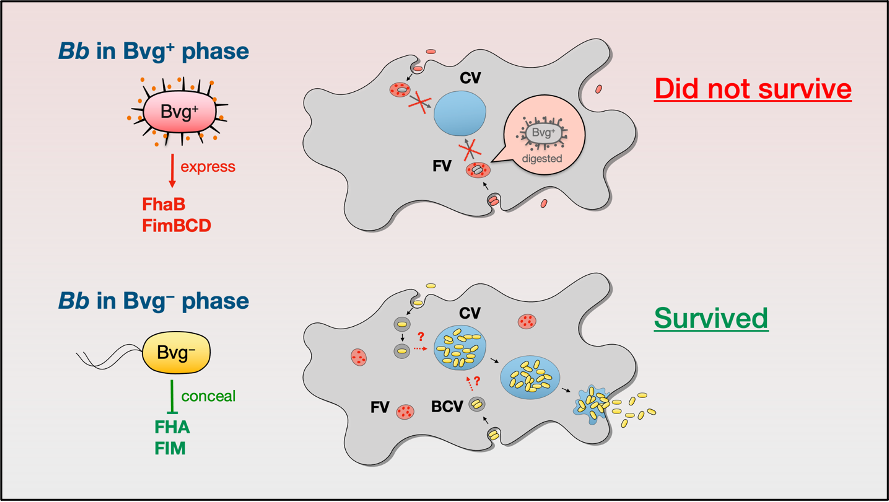The mechanism by which Bordetella bronchiseptica avoids predation by amoebae. (Horiguchi Lab, in Microbiol. Spectr.)
Research led by postdoctoral fellow Dendi Krisna Nugraha and Prof. Yasuhiko Horiguchi of the Department of Molecular Bacteriology has shown that B. bronchiseptica avoids predation by protists by changing the bacterial phenotype and utilizes them as transient hosts in natural environments.
Key research results:
- B. bronchiseptica proliferates better in coculture with amoebae than in single bacterial culture.
- B. bronchiseptica changes the phenotype to suppress the expression of filamentous hemagglutinin (FHA) and fimbriae (FIM), which are targeted by amoebae, and avoids predation.
- B. bronchiseptica can utilize protists as transient hosts in natural environments.
Research Details:
The Bordetella spp., including B. bronchiseptica, exhibit a reversible conversion between the phenotypes called Bvg+ and Bvg– phases, which is controlled by the BvgAS two-component system. At the optimal growth temperature of 37°C, the bacteria show the Bvg+ phase phenotype and express various virulence factors, which are necessary to infect various mammalian hosts. Conversely, below 26°C, the bacteria become the Bvg– phase to suppress virulence factor expression. The Bvg− phase is considered necessary for the survival of B. bronchiseptica in natural environments, which may be a source of infection; however, why the Bvg– phase bacteria have an advantage for survival in natural environments has remained elusive.
Expecting repeated encounters of the bacteria with environmental protists, in this study, we aimed to investigate the survival of B. bronchiseptica in Acanthamoeba castellanii, a ubiquitous environmental amoeba, and to identify the bacterial genes related to survival ability. We found that B. bronchiseptica in the Bvg− phase, but not in the Bvg+ phase, survived and proliferated well after coculture with A. castellanii. Microscopic analyses revealed that B. bronchiseptica in the Bvg− phase was internalized by amoebae and transferred into contractile vacuoles (CVs)*, from which the bacteria directly escaped to the extracellular milieu. We also found that two bacterial adhesion molecules expressed in the Bvg+ phase, filamentous hemagglutinin (FHA) and fimbriae (FIM), were targeted for predation by the amoeba (Figure). These results suggest that the bacteria change the phenotype to the Bvg− phase at temperatures in the natural environments where amoebae live (~26°C), and shut down the expression of FHA and FIM. This study also highlights the indispensable role of the BvgAS two-component system, the master regulator for the Bvg phase conversion, in the survival of B. bronchiseptica in amoebae.
This article was published in Microbiology Spectrum on March 27, 2023.
Title: “Survival of Bordetella bronchiseptica in Acanthamoeba castellanii.”
Authors: Dendi Krisna Nugraha, Takashi Nishida, Yuki Tamaki, Yukihiro Hiramatsu, Hiroyuki Yamaguchi, and Yasuhiko Horiguchi
*Glossary:
CV: Intracellular compartments of amoebae involved in osmoregulation.
Links
-
A. castellanii may target FHA and FIM to facilitate the digestion of B. bronchiseptica (Bb) in the Bvg+ phase (top). Bb in the Bvg− phase survives from A. castellanii digestion by shutting down the expression of both adhesins (bottom). CV (Contractile Vacuoles): Intracellular compartments of amoebae involved in osmoregulation. FV (Food Vacuoles): A type of vacuole that digests food particles ingested by the amoebae. BCV (Bb-Containing Vacuoles): Vacuoles in which Bb is localized.
- Home
- Achievement
- Research Activities
- The mechanism by which Bordetella bronchiseptica avoids predation by amoebae. (Horiguchi Lab, in Microbiol. Spectr.)








